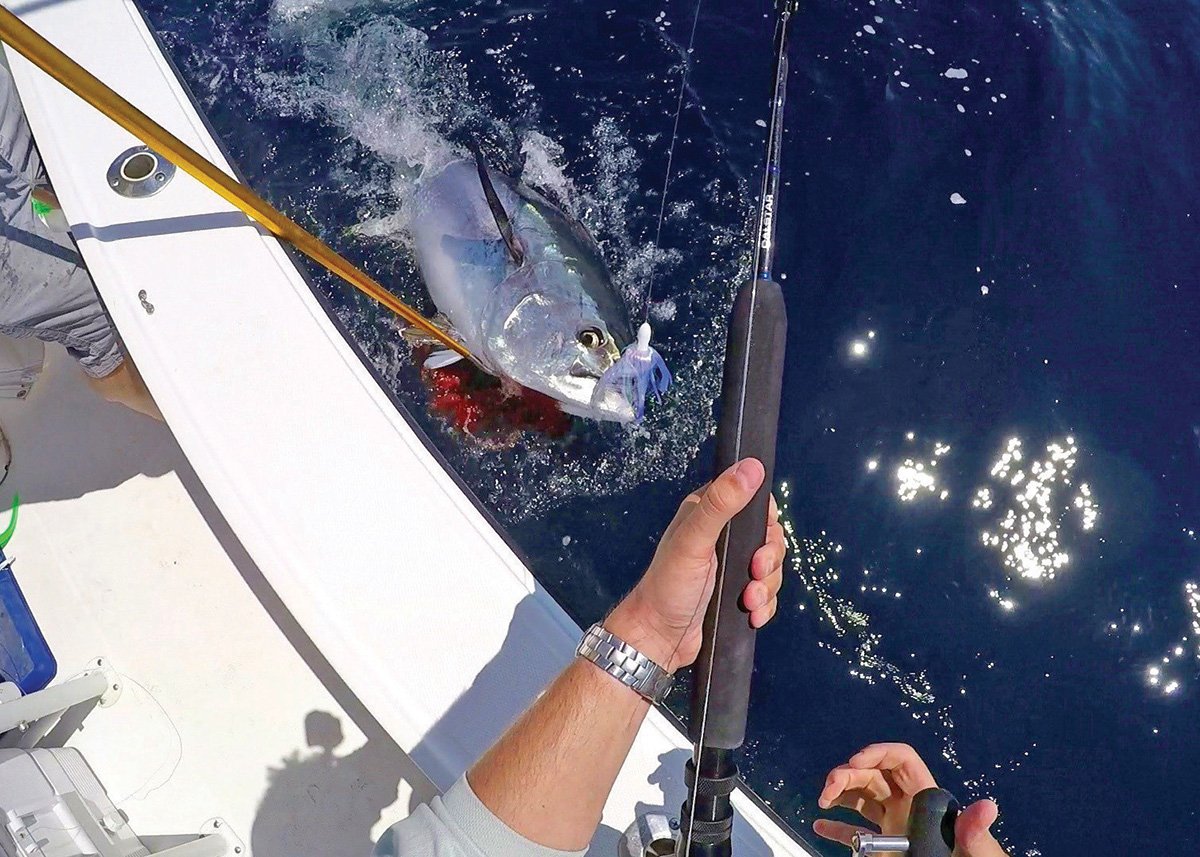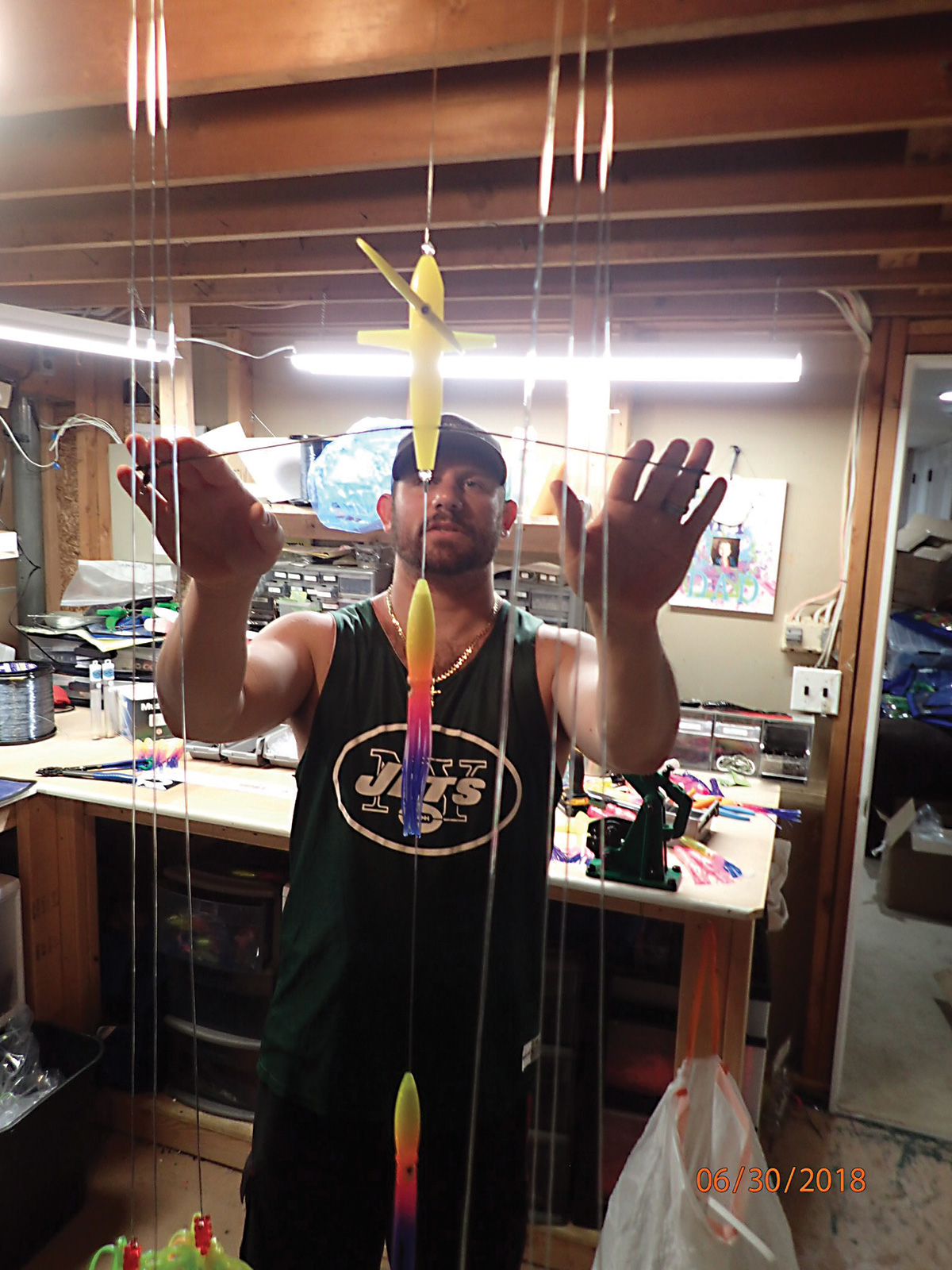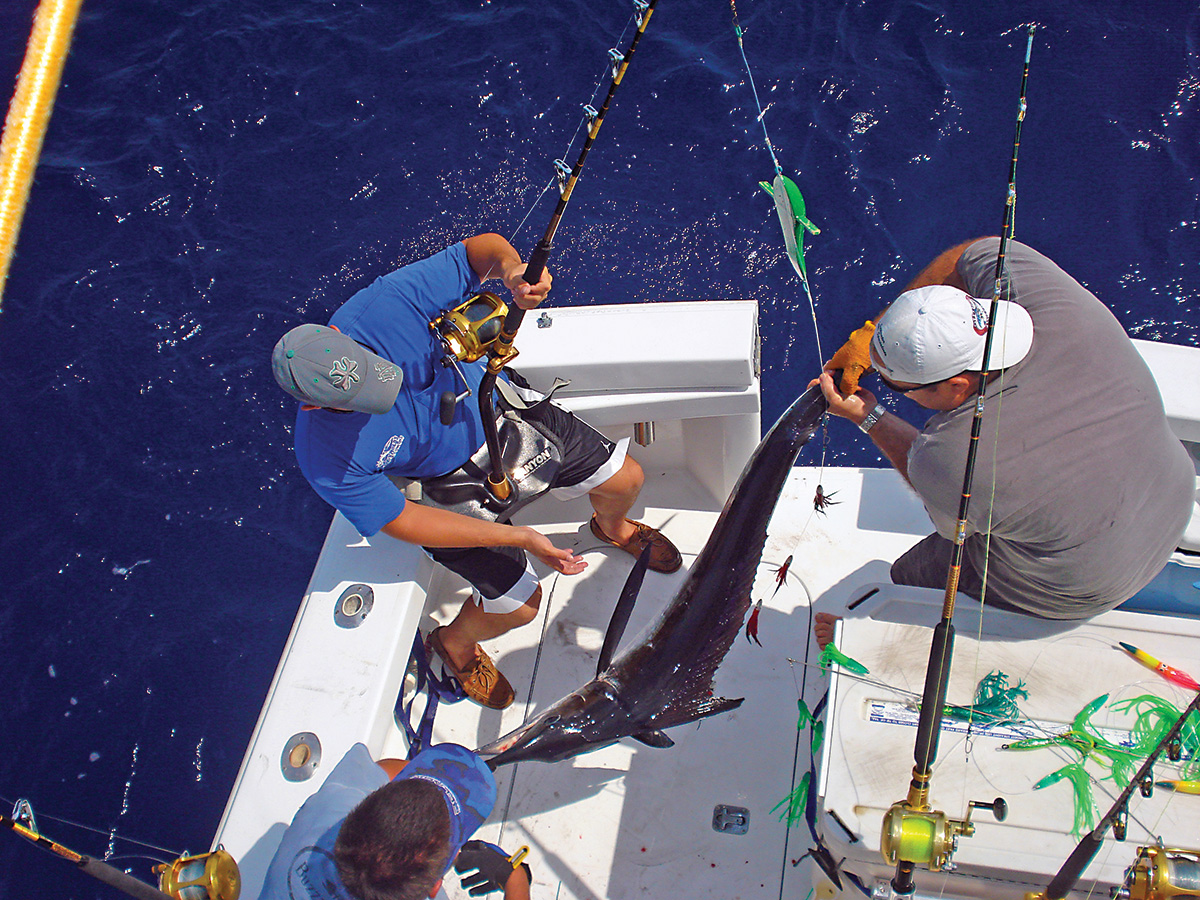
Trolling got its start with simple carved bone hooks and hand tied animal hair skirts. These were slow trolled as fast as the wind, current or paddle power allowed—a far cry from where we are now. The trolling process in the ‘70s and ‘80s was mostly fresh natural baits including rigged squid, mackerel, ballyhoo, belly strips and others. Methods of rigging and sewing baits changed as well. Deboning, adding chin weights and other tricks started to surface. As more captains started trolling a plethora of artificial lures hit the market. These lures were deemed inferior but, as cedar plugs, drones, tuna clones and green machines out produced natural baits, anglers took notice. As newer artificial lures caught fish equally as well and were easier to procure, the use of fresh trolling baits greatly dwindled (with the exception of ballyhoo). In the past there were more fish and less boats to compete against. Fast forward to today and the offshore grounds are flooded with 26- to 40-plus-foot center consoles. They are able to run to the canyons at 40 knots. This coupled with smaller stocks of fish often results in challenging conditions. These challenges help inspire innovations in tackle and techniques. If you want to be a winner you have to stay ahead of the game (or at least the fleet). Remember good lures catch fishermen, great lures help fishermen catch fish and stand the test of time.
Recent Enhancements
Ballyhoo Rigs: Ballyhoo have traditionally been fished naked or with a skirt. The addition of a skirt not only adds action and color but helps prevent the trolled bait from washing out. Many years ago the Ballyhood Company added a hollow head to the skirt. The nose of the ballyhoo snuggly fits into this “hood.” This added to the bait’s longevity and assisted in the way the bait tracked. A few years latter Joe Shute came on the scene adding weight to the nose and streamlined its appearance. This hydro dynamic enhancement allowed even poorly rigged ballyhoo to track straight. The head even has a notch that keeps pin rigs perfectly in place. These lures come in various weights and colors and are built to last. Pro Tip: When trolling, stopping the boat but keeping it straight, allows the weighted ballyhoo to sink. When the boat is put back in gear the lures act like baits fleeing to the surface.
Night Fever: Trolling after the sun sets is nothing new. Tred Barta, Jamie Hummel and Chuck Foreman fishing out of Shinnecock Inlet did this back in the 1980s. I am sure there have been countless others who have utilized this tactic over time as well. New to trolling in the dark is the advent of glow in the dark and electric flash lures. Instead of taping cyalume sticks to the rig, now the entire lure is constructed of glow material. Once activated they glow for a few hours before needing a quick recharge. Also hitting the scene are resin head lures that have strobes imbedded into them. They have two probes which, when connected by water set the strobe pulsing. These are great additions to night trolling, not only to assist the fish in zeroing in on your offerings, but they also assist the anglers in setting out a spread. Pro Tip: Number your rods, and set your spread out before dark. This enables you to see how and where things track. Use small rubber bands or a sharpie and mark the line just after the rod tip. If you have to reset them in the dark you know exactly when to stop letting line out.

Dredges, Dredge Booms: Teasers have been around forever. A teaser is anything that is run in your spread and is not rigged with a hook. Dredges are a teaser that have evolved over time to represent a subsurface school of baitfish. These are often trolled with 1- to 2-pound dredge weights, which is not ideal for fighting a hooked fish. Dredges are pulled to attract fish into the spread where hopefully they spot a solo hook bait that is trolled in close proximity. The latest developments have been collapsible dredges that store easily on smaller boats. There are also dredges that are snapped together in tiers; this allows you to select a smaller deployment option and also easier storage. Dredge booms have been a popular alternative to the standard downrigger or rod and reel method. Historically 80-pound class rod and reels, and or, downriggers were used to pull dredges. With storage a major challenge on smaller canyon boats, a better mouse trap had to be developed. The dredge boom is a strong metal side rigger that locks into a rodholder and can withstand the drag pressure of pulling a dredge. They store easily and are a much cheaper option.
Spreader Bars: These were developed by combining different size daisy chains. Both daisy chains and spreader bars have become staples in most trolling arsenals. The idea is to add as many baits as possible to your trolling pattern. Early bars had three to five hooks on them (at the end of each chain). That proved to be disastrous with multiple hook ups destroying the bar and resulting in lost fish and gear. The standard now is one stinger bait usually larger and a little further back to entice the fish to strike and become hooked. Trailing fish can and will hit the other offerings but normally they just let go. Made popular by Canyon Runner, float bars were the next innovation. These are rigged with Styrofoam floats inserted in each plastic squid. This allows for easy deployment and less drag, which makes them perfect for being fished from your outriggers. When a fish hits another bait, to clear these lines, you can crank them in and let them hang from the riggers sitting on the surface of the water. This saves you time when resetting your spread and helps keep your cockpit uncluttered.
Bird Teasers: These are used to add surface noise and commotion to a trolling presentation and are usually pulled ahead of a daisy chain or single lure. The most commonly used birds are manufactured by Boone and Williamson. Smaller versions of these birds are now being used to make splash bars. Some bars have one large bird and others have three to five smaller birds on each leg of the bar. The idea is to create what looks like surface feeding and splashes. Taking this one step further, Chatter Lures has created a side planing bar that also adds surface splashing or “chatter.”
Side Tracker Spreader Bars: These are one of the latest additions to the offshore arsenal, having evolved from planer boards and splash bars. They allow boats of all sizes to widen their trolling pattern. I admit I was skeptical at first. I figured whatever swam that close to my spread would eventually turn into it, so why bother? What I have discovered is that the wide side trackers are often the first lure to get hit, and that competing fish then throw caution to the wind and pile into my spread. This initiates multiple hook ups from fish that may not have come up. Fished either off an outrigger or a rod tip, their placement in front and next to the wake puts them in the clearest spot of the trolling pattern, where they often serve as the initial attractor. There are a few different types of these bars available, but my personal favorite is manufactured locally by Chatter Lures. What separates them is the versatility of the bird. Its adjustable locking feature allows it to track from either the port or starboard side. They are also self-righting, which makes them a breeze to deploy www.chatterlures.com.

Something Old, Something New
Popular colors and lures are constantly changing. It can drive tackle shop owners crazy trying to figure out what to stock and when. Ten years ago zucchini and Mexican flag were the hot colors. A few years later it was clown or rainbow. Lately, blue/white, pink, and black/purple have been hot colors. Joe McBride, a popular Montauk captain once said, “The color of the lure doesn’t matter, as long as it’s green.” If you are new to the game you can’t go wrong by starting off simple and purchasing green lures. Over time, see what works and add to your arsenal. Don’t be afraid to ask questions. If a certain lure or color was hot in the morning at Hudson Canyon, it doesn’t mean it will atomically work at the Coimbra that afternoon given the different time of day, angle of the sun, different baitfish, different surface conditions, etc.
In general the types of lures haven’t changed much. There have been a few innovations and changes to materials and manufacturing methods. Cedar plugs are making a big come back lately. They are a very simple lure that tracks well. The trick is open-hand jigging them. The lead nose causes them to turn and dart side to side with each pull. That being said, the newer machined metal and plastic options do not jig as well. Traditional wood and lead weighted ones are the way to go. Go through your basement and garage. Dig out some of those oldies but goodies, re-rig them and give them new life.
Conclusion
Hunt for new ideas. Read old copies of archived fishing articles. See what worked in the past, and be open to trying these techniques now. Be creative and modify old products and techniques to suit current day needs. Analyze reports and pictures for what’s working. Look in the background of photos for what’s on the other rods or on deck. Walk the docks and notice what captains and crews are cleaning and especially re-rigging. Research and contact manufacturers online; most love to talk about their products. Stick with what works but don’t become a victim of your own success. If green machines are what’s hot and all you fish are green machine chains, bars and lures, when you finally hook up, OMG these lures are amazing. But did it take you five hours to finally get bit? Did you run over fish and not raise them? Were other guys hooking up and you were just watching? They did eventually bring you success, but ask yourself, was there something more productive? You have to be willing to change things up on the fly. Dig through your arsenal and pull out one of your old favorites. Be willing to experiment, make changes, and learn. It will make you a better fisherman.



